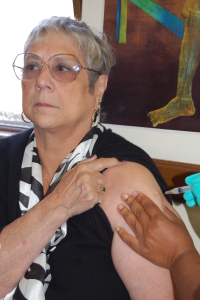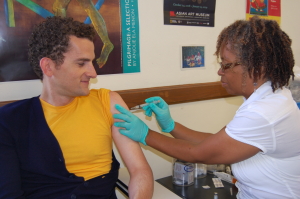The state saw a five-fold increase in the number of reported cases of whooping cough in the first half of 2010, compared to the same period last year.
Whooping cough is the common name for pertussis, a bacterial respiratory infection that causes a persistent, fitful cough that can be life-threatening for infants. Highly infectious, it gets its name from the characteristic “whoop” sound that happens as people gasp for breath. But the name might be misleading. Many babies under six months of age who contract pertussis don’t develop the whoop, said Dr. Stephen Parodi, chair of infectious disease for Kaiser Permanente Northern California.
Booster shot advised
Health care providers should be able to provide their patients with the Tdap booster shot, which is covered by insurance, said Amy Pine, director of the Communicable Disease Prevention Unit at San Francisco’s Public Health Department. And those who lack insurance can get the shot through their county public health department, either for a small fee or for free.
At the Adult Immunization and Travel Clinic at San Francisco’s Department of Public Health, almost 500 people have received the Tdap shot in July. That’s twice as many as did in July of 2009, said Pam Axelson, the clinic’s nurse manager.
“We’re getting a good response,” she said.
Elsie and William Leal dropped by for their shot because their daughter is six weeks away from giving birth to their sixth grandchild, a boy.
 Elsie Leal got the booster shot to protect her soon-to-be-born grandson. Credit: Gabriela Quiros
Elsie Leal got the booster shot to protect her soon-to-be-born grandson. Credit: Gabriela Quiros
“We want to make sure that we don’t give him anything,” said Elsie Leal. Everyone in their family, from their 25-year-old grandson to their 3-year-old granddaughter is in the process of updating their pertussis immunization. “Anyone who wants to see the baby is going to get it,” she said.
This is the response public health officials are hoping for. Though pertussis affects both adults and children, infants under six months are the most at risk for infection and death, due to the fact that they are not yet fully immune to the disease. Babies receive immunizations against pertussis, which are called DTaP, at two, four and six months, then again between 15 and 18 months. Infants aren’t fully immune until they have received the first three doses.
“We try to promote the concept of cocooning,” said Amy Pine, of San Francisco’s Public Health Department. “This is vaccinating anyone around a child who’s too young to be vaccinated.”
The state is recommending that anyone older than age seven receive the booster shot. Health providers are giving priority to pregnant women and women who have just given birth, as well as the people in contact with children under one or pregnant women. They’re also prioritizing health care workers.
Interviews with people getting the shot Wednesday show that information on the epidemic hasn’t yet reached all health providers. Leal said it took her a week to find a place that would give her the Tdap. She said that both her obstetrician and her primary care doctor refused to immunize her.
So did the pharmacy near her house in Dolores Heights, which told her that the shot is only for people under 64. Leal is 72. Nurse Axelson said that the booster shot also is safe for people over 64. She added that Leal’s doctors’ refusal to give her the booster shot might be related to the fact that ordering vaccines is a time-consuming process for doctors’ offices, involving significant paperwork.
The state Department of Public Health doesn’t track the number of adults who are immunized against pertussis, said Ralph Montano, spokesman with the department. But it does track the number of kindergartners who have received their shots. He said that 98 percent of children entering kindergarten in California have been immunized.
Statewide, about 43 percent of adolescents have been immunized against whooping cough, according to the U.S. Centers for Disease Control.
Closing the immunization gap
Immunity against pertussis wears out with time, said Kaiser Permanente's Stephen Parodi. Children should get another shot between 4 and 6, and then another one at 11. Adults who haven’t received a booster shot should get one, and research is ongoing as to how long the immunity provided by that shot will last, he said.
Until the Tdap booster shot was developed in 2005, adolescents and adults didn’t have a way to keep up their immunity against the disease. Now that the booster shot exists, public health leaders are looking for a way to make sure that adolescents receive it. Most states have established a mandate for adolescents to get the shot around the time they enter 6th or 7th grade. California is one of 11 states that have no such mandate.
California Assemblyman Juan Arambula, I-Fresno, is sponsoring a bill that would change that, by eliminating the age limits now set by the state Health and Safety Code. The code now says that public health officials can only compel children to get vaccinated against pertussis before they turn seven.
The measure, AB 354, passed the Assembly by a vote of 74-2 in May and is awaiting a vote in the state Senate. [UPDATE: Governor Schwarzenegger signed the bill into law on Sept. 29. Starting in July 2011, children entering grades 7 through 12 will have to show proof that they received a whooping cough booster. As of July 2012, only children entering 7th grade will have to get the booster shot.]
Disease misdiagnosed
Health officials are concerned that doctors might be misdiagnosing the disease. In all six deaths this year, health providers who saw the babies misdiagnosed the disease.
A seven-week-old girl who died in Los Angeles County earlier this month was misdiagnosed by her doctor three times and by emergency care personnel twice, according to a summary of her case distributed to public health leaders by the state Department of Public Health.
“People don’t recognize it,” said Resignato. Doctors may confuse pertussis with an upper respiratory infection, bronchitis, allergies, or a cough caused by asthma, he said.
Initially, pertussis can look like a common cold, causing a runny nose and maybe an achy, sore throat, said Parodi. That is followed by what he described as an annoying cough that typically lasts two weeks, but can last up to six weeks. The cough can be so bad that it causes patients to pass out or throw up.
“This can be a particular problem for little children,” said Parodi. “They can have trouble with breathing. This is what gets people to the hospital.”
The disease is treated with antibiotics. Patients are contagious from when they become ill until three weeks afterward. If they receive treatment, they will no longer be contagious after five days of antibiotics. The recovery period can take six to 14 weeks from when the patient first got sick.
“That’s another good reason to get vaccinated,” said Parodi. “Who wants to be sick for three months?”
Latinos disproportionately affected
Latino babies under six months are getting infected at a much higher rate than other babies that age. According to the state Department of Public Health, Latino babies under six months old have a rate of infection of 94 per 100,000 babies – twice the rate of African-American babies and almost three times the rate of white babies.
All of the four baby girls and two baby boys who have died from pertussis this year were Latino and hadn’t yet turned two months old. Three of them lived in Los Angeles County, and one each in San Bernardino, Fresno and Stanislaus counties.
Public health officials said Latino newborns might be at a higher risk for infection because they live with extended families, which puts them in contact with more people. Latinos in California are also under-immunized, said pediatrician Jaime Ruiz, from the Mission Neighborhood Health Center in San Francisco.
“The Latino population isn’t always aware that there are clinics where they can get vaccines for free, if they qualify by income,” said Ruiz. “And if they are migrant farm workers, they are moving around.”
 Neal Snider, 34, got his whooping cough vaccine at San Francisco's Adult Immunization and Travel Clinic on Wednesday. His wife is seven months pregnant. Credit: Gabriela Quiros
Neal Snider, 34, got his whooping cough vaccine at San Francisco's Adult Immunization and Travel Clinic on Wednesday. His wife is seven months pregnant. Credit: Gabriela Quiros
